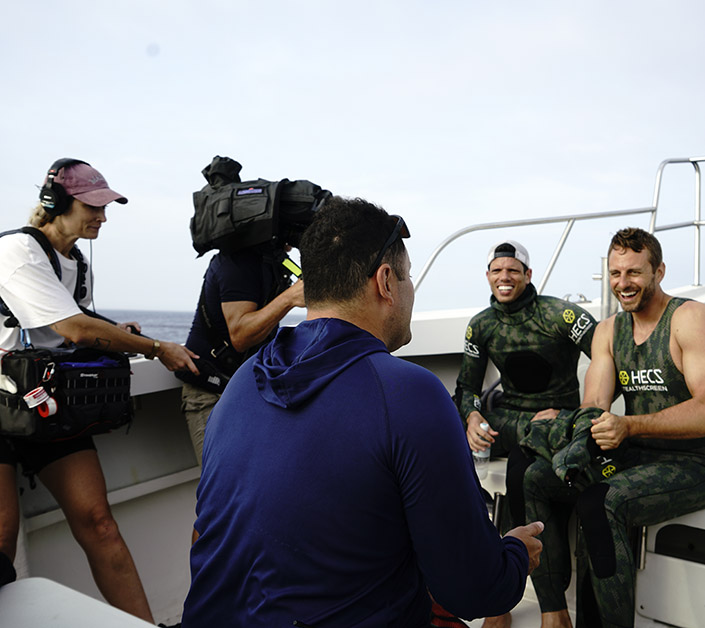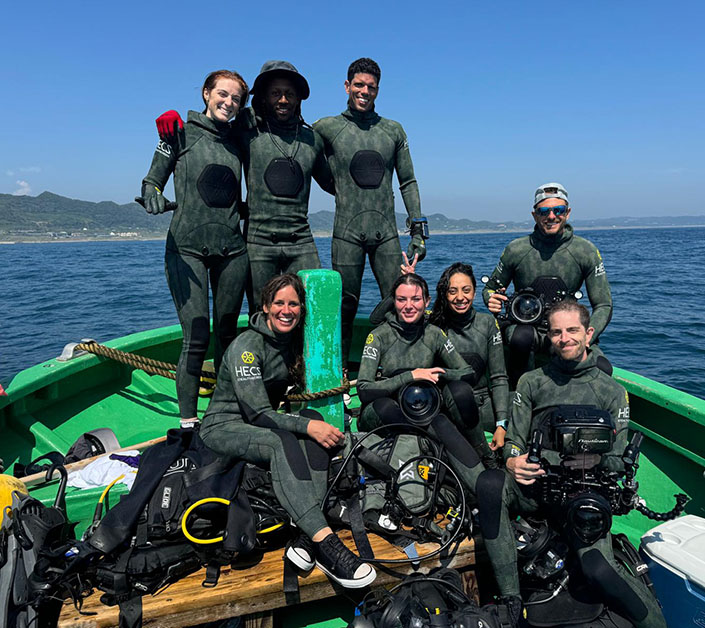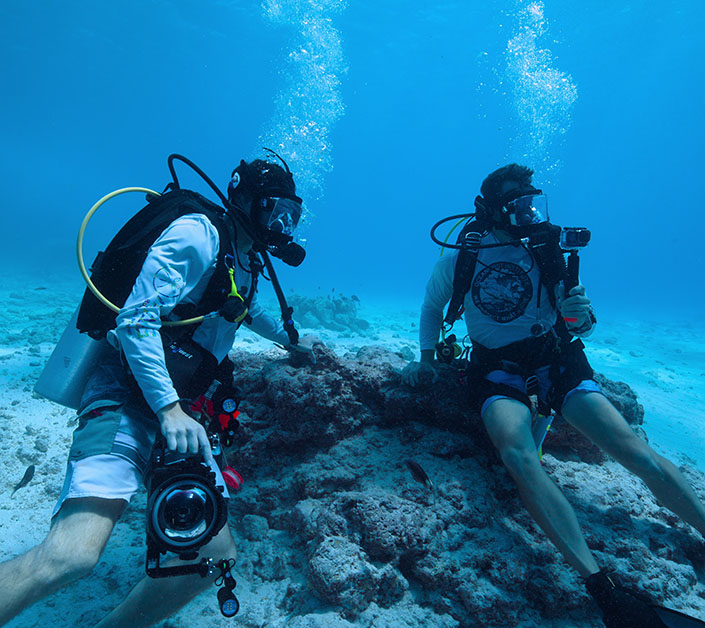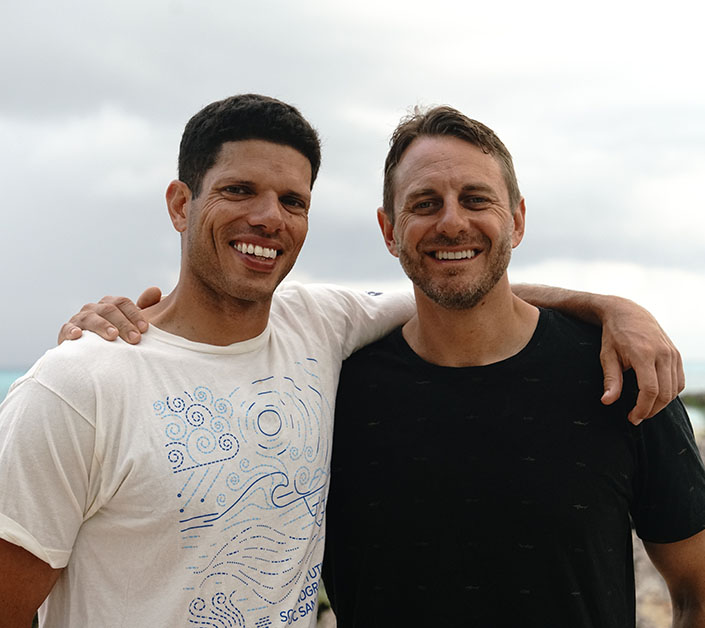Malinda Danziger, UC San Diego

Spoiler Alert: This story reveals the winners of “All the Sharks” on Netflix. Continue reading at your own risk.
When “All the Sharks” premiered on Netflix this summer, Brendan Talwar, a postdoctoral scholar at Scripps Institution of Oceanography at UC San Diego, emerged as a local fan favorite.
A marine fisheries ecologist, Talwar was partnered with a friend, colleague and marine biologist, Chris Malinowski from the Ocean First Institute. The six-episode competition series challenged four teams of ocean enthusiasts to compete in real-time marine fieldwork over two months —collecting photos of sharks in their natural habitats in exotic locations including the Maldives, the Galápagos Islands, The Bahamas, South Africa, Japan, and Australia’s Great Barrier Reef. The rarer the shark, the more points awarded.
The team of Talwar and Malinowski, better known as “Shark Docs” was crowned kings of the sea and received the ultimate prize: $50,000 for their chosen nonprofit organizations, Reef Environmental Education Foundation and Ocean First Institute. (They also got a cool shark-shaped trophy.)
We caught up with Talwar to talk about what the experience taught him about science, storytelling and the power of sharks to connect us to the ocean.

Team Shark Docs, Talwar and Malinowski, film an interview in Japan’s Tokyo Bay before diving Oshima Island.
How did you hear about the show?
Brendan Talwar: Chris and I received an email that read: “We are producing a global series that will feature the most biodiverse exploration of sharks that has ever been done.” How could we say no? But, of course, we nearly did. It seemed too good to be true, and our scientific minds poked countless holes in the idea of participating. Would it help or harm our careers? Would it be worth the time we could spend publishing papers?
As my Scripps advisor, Brice Semmens, explained: Worst case—you don’t like the show but get to dive together in some of the last remaining near-pristine marine ecosystems the world can offer. Best case—the show plays a part in inspiring the next generation of marine biologists, showcases the wide diversity of sharks and rays in our oceans, and makes a global audience excited about these animals and their habitats, many of which are under increasing threat. So, we decided that the goal of the show was worth the risk, with every encounter with a shark or ray a “win” for the audience.
What was filming like?
BT: I’ve always preferred being behind the camera—taking the group photo, rather than being the focus. Upon landing in the Maldives, I quickly realized this was going to be the opposite experience. At any given moment, we were filmed from three directions: the close-up to capture our reactions, the wide shot from a drone buzzing nearby and the split shot from just below the water’s surface.But we got to know the crew behind the camera on such a personal level that, two months later, we barely felt like we were being filmed at all, and the moments captured on camera were more genuine than ever.

The contestants from “All the Sharks” in Tokyo Bay, Japan, the dive site of the third episode.
Were there any moments that surprised you?
BT: The moment that surprised us most was shortly after arriving at Darwin’s Arch, in the northernmost corner of the Galápagos Island, hundreds of miles off Ecuador’s coastline. We were seeking whale sharks, worth 100 points each in the competition, at one of the most famed dive sites on Earth. But, after sitting in Darwin’s Theater 80 feet below the arch on back-to-back dives with nothing but scalloped hammerheads in sight — a diver’s dream in any other context — we started to question our decision to make the journey there from Wolf Island, where we were racking up points left and right photographing other species.
Back on the boat, scanning the horizon, we saw an enormous black dorsal fin slicing through the chop a few hundred meters away. We asked the captain to position the boat far ahead of the fins before slipping back into the water. After a few moments, a speck of white emerged from the depths, then another. Squealing into my snorkel like a kid at Christmas, I pointed straight into the black abyss as one of those white splotches grew into the shape of a juvenile killer whale rocketing up to meet us. The 16-foot-long youngster rolled gracefully to one side, curious to get a closer look at us before making an effortless kick to rejoin her family in the distance. Another pass, and the adults in the group sized us up, each of them a multi-ton bus, paying us just the slightest acknowledgement.
Sharing space with killer whales had been at the top of my bucket list since I saw the film “Free Willy” as a kid. They’re the true apex predators of the world’s oceans, taking out white sharks with ease, exhibiting complex social structures, and so much more — and swimming with them requires an acceptance and trust that they won’t harm you despite them having complete control over your wellbeing. In that moment, the whole premise of the show—the desire to connect people to the breathtaking wonder of the ocean — hit home.

Talwar and Malinowski wait patiently on the ocean floor to earn points for Team Shark Docs.
What was your favorite shark sighting?
BT: Across all six locations and four teams, our crew photographed over 50 shark and ray species — a remarkable percentage of their global diversity. (Fin fact: There are more than 500 species of shark and more than 600 species of ray.)
My favorite shark sighting was the leopard catshark off South Africa’s rugged coastline. I hadn’t heard of these little sharks before studying up for that episode, and they’re truly some of the most beautiful fish in the sea: gorgeous leopard-print patterns that vary between individuals, barbells resembling whiskers, and a fearless attitude encouraging this small, food-motivated shark to forget about personal space in the cutest way imaginable. At just under three feet long, they’re residents of cold, vibrant reefs off Port Elizabeth and surrounding seas, but nowhere else.
My favorite shark photograph, without question, was the great hammerhead that found our chum slick in Bimini, The Bahamas. We were facing elimination (after scores were reset to zero for each team) when a full-grown great hammerhead cruised into view between scraps of fish and the feet of our excited team. I had the camera when she first appeared, and dropped into the seagrass just in front of a piece of bait, lying tight against the seafloor to invite her in. Despite their enormity and position at the top of the food web, great hammerheads (and other hammerheads in the same family, Sphyrnidae) can be quite shy. As she came closer, she picked up on the scent of the bonito filet we were using as bait, swam right over it, and turned on a dime to scoop it up, looking dead into the camera lens while curling toward me. With her hammer — or cephalaphoil — parallel to my lens, I snapped a straight shot of her face, mouth slightly ajar. I’ll never forget this image: a single frame capturing the beauty and resilience of a critically endangered species finding refuge in a shark sanctuary, drawing in ecotourists and film crews with the hope of catching a glimpse.

Winning the competition offers an opportunity to showcase your research — what does this mean to you and your work?
BT: Winning mattered because it meant our work and message could reach a wider audience. Our message, about everything from ecology to conservation to the value of research, made the final cut because we were featured in every episode. These messages were easy to miss because entertainment masked the education, but they snuck in — defining endemism in Japan, highlighting our use of shark tracking data in Galápagos dive planning, even mentioning the importance of sound to draw in bull sharks in The Bahamas.
Conservation is a large bucket in which research, outreach, policy, storytelling and education reside. Although I’ve prioritized each of them at different phases of my career, online outreach has often taken a backseat. But given the opportunity of the moment, I’m working with Chris to leverage media interest to share urgent messages about shark conservation and, more broadly, healthy oceans. We’re primarily tackling this opportunity through our Instagram (@Shark_Docs) and podcast, “Beyond All the Sharks,” where we host discussions with researchers and conservationists in each location featured on the show to learn more about local species, ecosystems, and threats to sharks and rays.
How did you select your charity, Reef Environmental Education Foundation (REEF), to receive a portion of the winnings?

Team Shark Docs features Scripps Oceanography researcher Brendan Talwar (left) and marine biologist Chris Malinowski (right). Photo courtesy of Netflix.
BT: We chose REEF because their mission of monitoring reef fishes and marine life through citizen science aligns with our deepest values. REEF empowers everyday divers to become scientists and stewards of the ocean, and that’s the kind of future we want to help build. Their volunteer divers have conducted hundreds of thousands of REEF fish surveys, creating datasets that have fueled scientific research, informed resource management and supported conservation worldwide. We even used REEF’s dataset in “All the Sharks” to guide our dive planning. Before going to each site, we mapped hotspots of shark and ray sightings using REEF observations, which informed our search for each species on the scorecard.
At the Semmens Lab at Scripps, we’re using REEF’s powerful long-term dataset to uncover trends in shark and ray populations across the Caribbean—filling major data gaps to inform national policies and IUCN Red List assessments and better measure the effectiveness of conservation actions, such as Shark Sanctuary designations. With support, we aim to expand this low-cost, high-impact work and bring the science behind “All the Sharks” to life.
What's next for you?
BT: I’m here at Scripps Institution of Oceanography until next September. After that, my funding—tied to research on healthy seafood—will expire. In a perfect world, I’d stay at Scripps and build on the legacy of San Diego scientists who have studied local shark and ray species for decades.
However, recent funding cuts and shifting priorities have dramatically reduced regional shark research and conservation efforts. The primary threat to shark populations—overfishing—continues to grow and evolve, shifting from the high seas to coastal zones. With many of the species in Southern California’s waters caught by intensive fisheries elsewhere, the importance of local refuge habitats is growing by the day.
At both regional and international scales, applied research is urgently needed. Implementing responsible fisheries management and protecting critical habitats requires dedicated work that draws on multiple disciplines—from ecology and oceanography to policy and community engagement. That’s the kind of collaborative expertise that Scripps scientists are uniquely positioned to provide. With access to diverse species and rich ecosystems and deep ongoing partnerships with NOAA, other state and federal agencies, and international fisheries management organizations, I envision a program at Scripps that develops cutting-edge tools to better understand these predators and works strategically to reduce their risk of extinction.
Talwar’s research aims to protect vulnerable shark species while supporting the livelihoods of fishing communities around the world. By combining interdisciplinary research with hands-on education and outreach, his work helps chart a more sustainable future for the ocean. As he looks ahead, Talwar hopes his “All the Sharks” experience inspires others—especially the next generation of marine scientists—to see sharks and rays as important parts of healthy and vibrant marine ecosystems that bring joy to people everywhere. “If we want people to care about the ocean,” he says, “we have to tell stories that help them feel part of it.”

